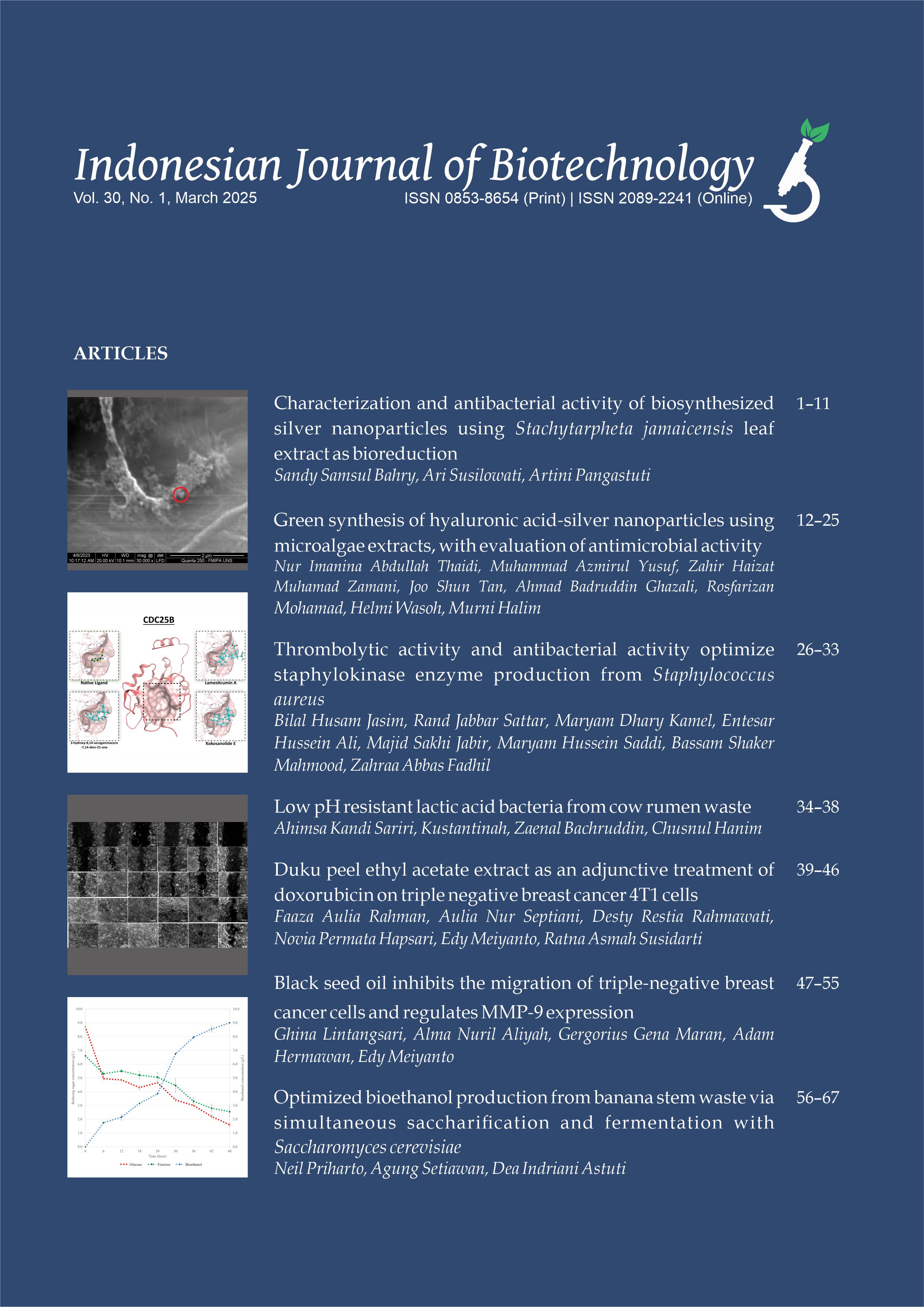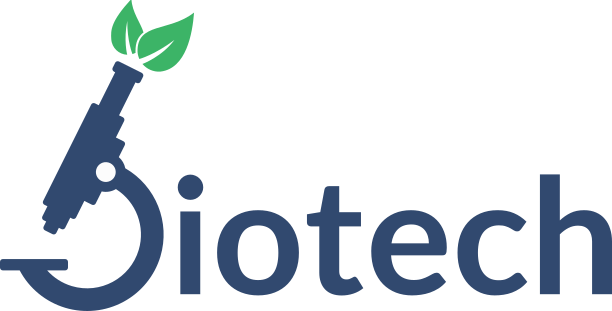Low pH resistant lactic acid bacteria from cow rumen waste
Ahimsa Kandi Sariri(1), Kustantinah Kustantinah(2), Zaenal Bachruddin(3), Chusnul Hanim(4*)
(1) Animal Science Department, Universitas Veteran Bangun Nusantara, Jl. Sujono Humardani No. 1 Jombor, Sukoharjo, Jawa Tengah, Indonesia
(2) Faculty of Animal Science, Universitas Gadjah Mada, Jl. Fauna No. 03, Karang Gayam, Caturtunggal, Depok, Yogyakarta 55281, Indonesia
(3) Faculty of Animal Science, Universitas Gadjah Mada, Jl. Fauna No. 03, Karang Gayam, Caturtunggal, Depok, Yogyakarta 55281, Indonesia
(4) Faculty of Animal Science, Universitas Gadjah Mada, Jl. Fauna No. 03, Karang Gayam, Caturtunggal, Depok, Yogyakarta 55281, Indonesia
(*) Corresponding Author
Abstract
This study aims to obtain a new strain of lactic acid bacteria (LAB) with the ability to survive at low pH, resulting from isolation, selection, and identification from rumen waste. The research included four stages: isolation of bacteria from rumen waste, selection, and identification. The selection procedure involved growth of LAB in a low pH medium. Molecular identification procedure was conducted using the 16S rRNA gene sequence amplification method with universal primers 27F (AGAGTTTGATCCTGGCT CAG) and 1429R (TAGGGTTACCTTGTTACGACTT). The results of the isolation and identification were analyzed descriptively, revealing that five petri dishes (5a, 10a, 10b, 16a, and 18b) contained lactic acid bacteria which produced clear zones. Among these, isolate 18b was the only LAB strain that survived in a pH 3.5 medium. The results of the molecular identification using the 16s rRNA gene showed that isolate 18b belonged to Limosilactobacillus fermentum.
Keywords
Full Text:
PDFReferences
Afrianto L. 2004. Menghitung mikroba pada bahan makanan, Cakrawala (Suplemen pikiran rakyat untuk IPTEK) [Counting microbes in food ingredients, People’s Mind supplement for science and technology]. Bandung: Department of Pharmacy, Faculty of Mathematics and Natural Sciences, Institut Teknologi Bandung.
Agussalim M. 2020. Isolasi, seleksi, identifikasi, dan aplikasi bakteri asam laktat dari fermentasi Chao ikan tembang (Sardinella gibbosa) [Isolation, selection, identification, and application of lactic acid bacteria from fermented Chao fish (Sardinella gibbosa)]. Dissertation, Universitas Gadjah Mada, Yogyakarta.
Cahyaningtyas Z, Kusmartono K, Marjuki M. 2019. Sintesis protein mikroba rumen dan produksi gas in vitro pakan yang ditambah urea molasses block (UMB) yang mengandung ragi tape sebagai sumber probiotik [Rumen microbial protein synthesis and gas production in vitro of feed supplemented with urea molasses block (UMB) containing tape yeast as a probiotic source]. J. Nutr. Ternak Trop. 2(2):38–46. doi:10.21776/ub.jnt.2019.002.02.2.
Chenoll E, Macián MC, Aznar R. 2003. Identification of Carnobacterium, Lactobacillus, Leuconostoc, and Pediococcus by rDNA based techniques. Syst. Appl. Microbiol. 26(4):546–556. doi:10.1078/072320203770865855.
Marshall SH, Arenas G. 2003. Antimicrobial peptides: A natural alternative to chemical antibiotics and a potential for applied biotechnology. Electron. J. Biotechnol. 6(3):271–284. URL http: //www.scielo.cl/scielo.php?script=sci_arttext&pid= S071734582003000300011&nrm=iso.
Mount DW. 2001. Bioinformatics: sequence and genome analysis. Cold Spring Harbor, NY: Cold Spring Harbor Laboratory Press.
Reller LB, Weinstein MP, Petti CA. 2007. Detection and identification of microorganisms by gene amplification and sequencing. Clin. Infect. Dis. 44(8):1108– 1114. doi:10.1086/512818.
Singleton P, Sainsbury D. 1988. Dictionary of Microbiology and Molecular Biology. Singapore: John Wiley & Sons.
Soetrisno E, Barry TN, Wilson PR, Hodgson J, Purchas RW. 1994. Effects of grazing red clover (Trifolium pratense) or perennial ryegrass (Lolium perenne)/white lover (Trifolium repens) pastures upon growth and venison production from weaner red deer (Cervus elaphus). New Zeal. J. Agric. Res. 37(1):19– 27. doi:10.1080/00288233.1994.9513037.
Suardana IW, Suardana IW. 2007. Isolasi dan identifikasi bakteri asam laktat dari cairan rumen sapi Bali sebagai kandidat biopreservatif [Isolation and identification of acid lactic bacteria from Bali cattle’s gastric fluid as a potential candidate of biopreservative]. J. Veteriner 8(4):155–159.
Tamura K, Dudley J, Nei M, Kumar S. 2007. MEGA4: Molecular Evolutionary Genetics Analysis (MEGA) software version 4.0. Mol. Biol. Evol. 24(8):1596– 1599. doi:10.1093/molbev/msm092.
Widodo, Taufiq TT, Anindita NS. 2013. Fermented goat milk and cow milk produced by different starters of lactic acid bacteria: Quality studies. J. Agric. Sci. Technol. A3:904–911.
Widyadnyana DGA, Sukrama IDM, Suardana IW. 2015. Identifikasi bakteri asam laktat isolat 9A dari kolon sapi Bali sebagai probiotik melalui analisis gen 16S rRNA [Identification of lactic acid bacteria isolate 9A from Bali cattle colon as probiotics through 16S rRNA gene analysis]. J. Sain Vet. 33(2):56–61. doi:10.22146/jsv.17923.
Winurdana AS. 2016. Pemanfaatan inokulan isi rumen sapi yang dikombinasikan dengan bahan aditif terhadap kualitas fisik dan kimia hijauan jagung (Zea mays) [Utilization of cow rumen inoculant combined with additives on the physical and chemical quality of maize forage (Zea mays)]. Bachelor thesis, Brawijaya University, Malang.
Article Metrics
Refbacks
- There are currently no refbacks.
Copyright (c) 2025 The Author(s)

This work is licensed under a Creative Commons Attribution-ShareAlike 4.0 International License.









